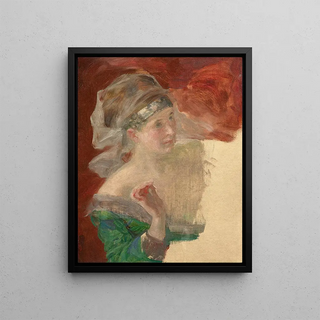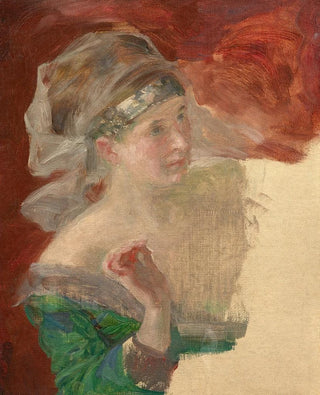Art print | Study of a lady in historical costume - Marie Bracquemond


View from behind

Frame (optional)
At the heart of French Impressionism, the artwork "Study of a lady in historical costume" by Marie Bracquemond stands out for its delicacy and sophistication. This piece, both a portrait and a genre study, evokes a bygone era while revealing the modernity of the artist's perspective. The depiction of a woman in historical costume is not merely a simple illustration of attire; it embodies a reflection on feminine identity and the role of women in 19th-century society. Through this work, Bracquemond invites us to immerse ourselves in a universe where elegance and beauty blend with profound introspection.
Style and uniqueness of the work
Marie Bracquemond's work is characterized by her subtle use of light and color. In "Study of a lady in historical costume", the artist plays with shades to create an atmosphere that is both intimate and refined. The details of the costume, carefully rendered, demonstrate undeniable technical mastery, while the lady's face, imbued with gentle melancholy, captivates the viewer. The composition is skillfully balanced, with a background that, although simple, highlights the central figure. Bracquemond manages to breathe life into her subject, making this artwork a true celebration of femininity and timeless elegance. Every brushstroke seems charged with emotion, revealing the artist's sensitivity towards her model.
The artist and her influence
Marie Bracquemond, often overshadowed by her male contemporaries, nonetheless played a vital role in the Impressionist movement. Wife of painter Félix Vallotton, she navigated a male-dominated artistic environment while asserting her own voice. Her work, though less known, influenced many artists of her time, notably through her ability to capture light and shadow in an innovative way. Bracquemond was also a pioneer in representing women, not only as muses but as subjects in their own right, endowed with psychological depth. Her contribution to art history deserves to be rediscovered.

Matte finish

View from behind

Frame (optional)
At the heart of French Impressionism, the artwork "Study of a lady in historical costume" by Marie Bracquemond stands out for its delicacy and sophistication. This piece, both a portrait and a genre study, evokes a bygone era while revealing the modernity of the artist's perspective. The depiction of a woman in historical costume is not merely a simple illustration of attire; it embodies a reflection on feminine identity and the role of women in 19th-century society. Through this work, Bracquemond invites us to immerse ourselves in a universe where elegance and beauty blend with profound introspection.
Style and uniqueness of the work
Marie Bracquemond's work is characterized by her subtle use of light and color. In "Study of a lady in historical costume", the artist plays with shades to create an atmosphere that is both intimate and refined. The details of the costume, carefully rendered, demonstrate undeniable technical mastery, while the lady's face, imbued with gentle melancholy, captivates the viewer. The composition is skillfully balanced, with a background that, although simple, highlights the central figure. Bracquemond manages to breathe life into her subject, making this artwork a true celebration of femininity and timeless elegance. Every brushstroke seems charged with emotion, revealing the artist's sensitivity towards her model.
The artist and her influence
Marie Bracquemond, often overshadowed by her male contemporaries, nonetheless played a vital role in the Impressionist movement. Wife of painter Félix Vallotton, she navigated a male-dominated artistic environment while asserting her own voice. Her work, though less known, influenced many artists of her time, notably through her ability to capture light and shadow in an innovative way. Bracquemond was also a pioneer in representing women, not only as muses but as subjects in their own right, endowed with psychological depth. Her contribution to art history deserves to be rediscovered.






